![]()
with
information about items of interest and upcoming FONT pelagic trips with some narratives and
photos from previous trips, from the present back to early 2001.
The following are in
reverse-chronological order, with the most-recent first. Click link to any item you find of interest.
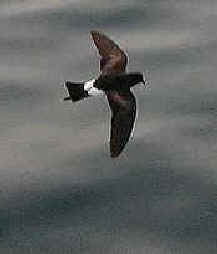
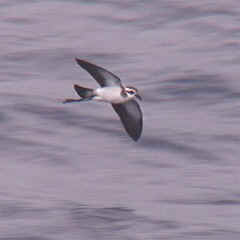
Here are further links to:
Upcoming
pelagic
trips & pelagic bird-lists
and
PHOTO GALLERIES
(FOR OCEANIC BIRDS & OTHER MARINE-LIFE)
Customers' Comments from Previous Pelagic Trips
FONT Pelagic Bulletins Links:
Upcoming
pelagic trip scheduled to go from New Jersey, USA in 2006
September 15/16, 2006 pelagic trip from Barnegat Light,
New Jersey cancelled due to bad weather
Pelagics
in the Sea of Japan on May 10 & 12, 2006 (as part of our '06 Japan Spring
Birding Tour)
A summary of our Nov 14, 2005 pelagic trip from Valparaiso, Chile (as part of our '05 Chile Tour)
A summary of our Sep 11, 2005 pelagic trip from Barnegat Light, New Jersey, USA
A summary of our Dec 5, 2004 pelagic trip from Barnegat Light, New Jersey, USA
A summary of our Sept 11/12, 2004 pelagic trip from Barnegat Light, New
Jersey, USA
(based on
input by
Kelp Gulls: subspecies &
expansion?
Lesser Black-backed Gulls in eastern North America
A Drastic Decline of Albatrosses & Penguins in the Falklands
Dec
7 '03 Pelagic Trip from Barnegat Light New Jersey cancelled
due to bad weather
Albatrosses
& Other Seabirds during FONT tours in Chile
Oceanic
Birds during 2 pelagic trips off Chile in November 2003
A
narrative summary of our Sept 7/8, 2003 pelagic trip from Barnegat Light, New
Jersey, USA
(largely based on
input by trip participant, Jared Sparks)
What was seen during our May 31, 2003 pelagic trip from Lewes, Delaware, USA
Sightings
during Dec 7 2002 Pelagic Trip from Barnegat Light, New Jersey, USA
Sightings during May 2002 Hudson Canyon pelagic trips from Point
Pleasant, New Jersey, USA
Sightings during June 2002 Pelagic Trip from Lewes, Delaware, USA
Sightings during Japan pelagic trip May 18, 2002 on East China Sea between Okinawa & Amami.
Caribbean Seabirds & Cetaceans, including Great Skua, Tropicbirds, and Fraser's Dolphin.
Sightings during Pelagic Trip Dec 1, 2001 from Brielle, New Jersey, USA
Pelagic Birding Trip off Chile, South America, Nov 2001
Sightings during Pelagic Trip off Cape May, New Jersey, USA, Sept 2, 2001
Sightings during Pelagic Trip at the Hudson Canyon off New Jersey, USA, May 25/26, 2001
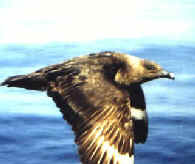
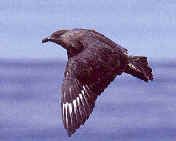
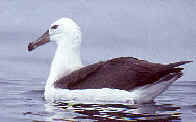
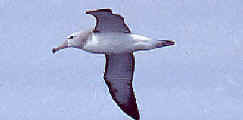
From FONT Pelagic Bulletin - September 16, 2006
Regarding the pelagic trip that was scheduled to go overnight from on the "Doris Mae IV" from Barnegat Light New Jersey, on Friday, September 15, departing at 11:00pm, unfortunately that trip had to be cancelled due to bad weather. The weather forecast for that night indicated improved conditions that simply did not materialize.
![]()
From FONT Pelagic Bulletin - May 21, 2006
Regarding the pelagic trip that was scheduled to go from Barnegat Light, New Jersey on Sunday, May 21, 2006, it can be summed up in two words: too windy.
![]()
From
FONT Pelagic Bulletin - May 15, 2006
Pelagics in the Sea of Japan off western Honshu (as part of our annual Japan
spring birding tour)
During the May 2006 FONT birding tour in Japan (our 26th tour there; our 10th in the spring), there were, on May 10th, thousands of Streaked Shearwaters seen from the ferry (an hour-and-a-half ride) to Hegura Island in the Sea of Japan. Also in flocks, there were hundreds, as many as a thousand, Red-necked Phalaropes.
The water of the sea was smooth. And, as it was like glass, the alcids sitting on the water were relatively easy to spot. Most were Rhinoceros Auklets. There were also Japanese Murrelets, which are endemic to Japan, endangered, and attractive black-and-white birds with a nice Japanese name, "Kanmuri-umisuzume". It's pronounced as it looks.
The alcids breed on rocky islets by which the ferry closely passes. On the slopes of those small islands, thousands of Black-tailed Gulls were at their nesting sites. Many were seen flying close to the boat.
During the return ferry-ride from the island a couple days later, Streaked Shearwaters still abounded. The sea was not as calm, and there was more of a breeze. So more shearwaters were seen in flight, probably as many as 20,000. During the earlier trip to the island, with different conditions, an estimated 10,000 were seen. It was fun to watch so many shearwaters, in flocks lifting from the water and flying about. The species is actually incredibly abundant over oceanic waters around Japan, where the total population is said to be between 2.5 and 5 million.
![]()
From FONT
Pelagic Bulletin - November 18, 2005
A Summary of our Nov
14, '05 Pelagic Trip from Valparaiso, Chile (as part of our annual Chile birding
tour)
FONT conducted, on
November 14, 2005, its 16th Pelagic Trip from Valparaiso, in conjunction with its annual Chile Birding Tour. During most years, since 1991, this trip has been in November.Over the years, many seabirds have been seen during this
Valparaiso pelagic trip. Some years, the number of birds has been quite high, when there have been thousands of Sooty Shearwaters and thousands of phalaropes. This year, that was not the case, as the number of Sooty Shearwaters was small, and no phalaropes were seen. Some years, the waters of the Humboldt Current off Chile have been filled with seabirds that reside there exclusively. Species in that category include Guanay Cormorant and Peruvian Boobies. This year, numbers of both of those species seemed to be lower than usual.The ocean off the Chilean coast can have not just high numbers of birds, but also a good variety of species. During our trip in 2005, there was an excellent variety, even though, as noted, some of the numbers, that given day, were down.
Seabirds come to that area of the Pacific Ocean, off Chile, from various places far away. Some of the Albatrosses (including the Salvin's and the Buller's) come from New Zealand, on the opposite side of the Southern Pacific. Other birds also come from there, including the rare Westland Petrel.
During our tour this year, the bird that was the highlight of our Chile Valparaiso pelagic came from New Zealand, where the species breeds. It was the Northern Royal Albatross. We've previously seen the Southern Royal Albatross during our trips over the years (at least once, maybe twice), but this was the first time for the Northern. What an exciting bird our Northern Royal Albatross was to see. It's big, very big. Its wingspan is as much as 138 inches. That's 11-feet, 6-inches, meaning that each wing is as much as 5-feet, 9-inches, the height of many people.
We saw the Northern Royal Albatross well, with those long wings in flight, and also as it was resting near us on the water. When the bird would take off from the water to fly, each time we watched its feet patter along the surface for 2 or 3 seconds, before the bird would become airborne. Our Northern Royal Albatross on Nov. 14, '05 was an immature bird.
When it was resting on the water near us, next to the Salvin's Albatross, the Northern Royal dwarfed that species, which is no small bird itself. The wingspan of the Salvin's Albatross is as much as 98-inches, or about 8-feet, or 4-feet per wing. We saw a few Salvin's Albatrosses, during our trip. And, there was yet another Southern Albatross, the Black-Browed.
During our Chile Pelagic Trips, since
1990, we've seen 9 species of Albatrosses:
Northern Royal
Southern Royal
Black-browed
Salvin's
Shy (or White-capped)
Chatham
Buller's
Gray-headed,
and Waved.
Other seabirds during our Nov. 14, 2005
pelagic, from Valparaiso, Chile were:
the Westland Black Petrel (as noted, from New Zealand), the White-chinned,
and Cape Petrels (the latter known as the Pintado), the DeFilippi's
Petrel (a pterodroma very similar to the Cook's Petrel), the Southern
Giant-Petrel (one followed us nearly all the way back to shore), the Southern
Fulmar, the Pink-footed and Sooty Shearwaters, the Humboldt
Penguin, Peruvian Booby and Peruvian Pelican, Guanay and Red-legged
Cormorants.
Gulls
included the Kelp, and this year many Franklin's Gulls. It's
interesting how Franklin's Gulls can be on the ocean off the Chilean
coast, revising their life-style in the Southern Hemisphere. In the Northern
Hemisphere, of course, they breed far from the sea, in the interior of the
United States and Canada. A Sabine's Gull was also with the seabirds
around our boat off the Chilean coast, where we also saw an astonishing 6
species of Terns Common, Arctic, South American, Trudeau's, Elegant, and Inca.
It was a good day at sea.
![]()
From FONT
Pelagic Bulletin - September 25, 2005
Other pelagic species during the Sept 17, 2005 Monterey pelagic, that was part of the FONT West Coast Tour, included Black-footed Albatross, Northern Fulmar, Short-tailed Shearwater, Sooty Shearwater, Pink-footed Shearwater, Buller's Shearwater, and 3 Storm-Petrels Ashy, Black, and Least. Also 3 alcids Common Murre, Pigeon Guillemot, and Rhinoceros Auklet, as well as Parasitic and Pomarine Jaegers, and South Polar Skua.
There were also some tremendous looks at
Marine Mammals. Among them, a group of 8 Baird's Beaked Whales, with 4 of them floating on the surface of the water close to the boat. And there were Humpback Whales 8 of them with their breaching out of the water, including such activity by a mother with her calf (apparently learning how to do it).![]()
From FONT
Pelagic Bulletin - September 20, 2005
A summary of our Sep 11 '05 pelagic trip from Barnegat Light, New Jersey to the
Hudson Canyon
The following account written by Armas Hill, based on
input by Fred Lesser, one of the leaders onboard the boat:
Our annual FONT
late-summer pelagic trip to the Hudson Canyon, off New
Jersey & New York, took place overnight on
September 11, 2005.
Our thanks to all: the captains and others with the boat (including those who
provided the food), our leaders & spotters, and to all who joined us as
participants.
We left the dock in the middle of the night (after midnight), and we were at the
Hudson Canyon at daybreak.
The water temperature was somewhat warmer that it usually is for this trip, at
about 74 to 76 degrees. Thus, there were warm-water birds such as AUDUBON'S
SHEARWATERS, with about 25 of them seen.
Among other birds were 2 juvenile LONG-TAILED JAEGERS, that were seen close to
the boat.
There were also CORY'S SHEARWATERS (about 20). And RED-NECKED PHALAROPES (6).
All of the birds just-mentioned were seen at the Hudson Canyon, thus in NY
waters (and about 90 miles east of Long Beach Island, New Jersey).
Landbirds were a PALM WARBLER and BLACK& WHITE WARBLER way offshore.
Marine mammals during our Sep 11 '05 trip included: a large FIN WHALE, a MINKE
WHALE, 2 CUVIER'S BEAKED WHALES (usually denizens of rather warm water), RISSO'S
DOLPHINS (also known as GRAY GRAMPUS), over 40 of them, and OFFSHORE BOTTLENOSE
DOLPHIN (12), and SHORT-BEAKED COMMON DOLPHIN (2).
Other marine life during the trip included: a fish known as the Wahoo, Oceanic
Sunfish (Mola Mola), Loggerhead Sea Turtle (3), Stinging Sea Nettle, and
creatures in the Sargassum Weed: crabs, shrimp, and fish.
In all, it was a nice day at sea.
Birds seen offshore during our Sep 11 '05 from Barnegat Light NJ included:
Cory's Shearwaters - 20
Audubon's Shearwaters - 25
Wilson's Storm-Petrels - 200
Red-necked Phalaropes - 6
Long-tailed Jaegers - 2
"Comic" (either Common or Arctic) Terns - 3 (some or all likely
Arctic)
Herring Gull - 4 (1 way offshore, at the canyon)
Great Blue Heron - 2
Northern Gannet - 4
Common Loon - 1
Black-and-white Warbler - 1
Palm Warbler - 1
Mammals:
Fin Whale - 1
Minke Whale - 1
Cuvier's Beaked Whale - 2
Risso's Dolphin - 40+
Offshore Bottenose Dolphin - 12
(Short-beaked) Common Dolphin - 2
![]()
From
FONT Pelagic Bulletin - December 13, 2004
A summary of the FONT Dec 5 '04 all-day pelagic trip from
Barnegat Light, New Jersey
Our annual FONT "early-winter" pelagic trip offshore from New Jersey took place on December 5, 2004, onboard the "Doris Mae IV" out of Barnegat Light, NJ. The weather was clear, the seas just a bit choppy. The water temperature was about 52 degrees F. The trip ventured to 55 miles from shore.
Birds seen offshore
during the trip were the following:
Red-throated Loon - 15
Common Loon - 15
Manx Shearwater - 1
Northern Gannet - 80
Great Cormorant - 1
Laughing Gull - 1
Bonaparte's Gull - 300
Herring Gull - thousands
Lesser Black-backed Gull - 1
Great Black-backed Gull - 25
Black-legged Kittiwake - 15
Razorbill - 9
Atlantic Puffin - 1
Dovekies were also in that area of the ocean, but during our visit the water got
just a bit too choppy to find them sitting on the surface.
The Manx Shearwater during the trip provided for most on the boat the best look
they've ever had of the bird. It was so involved in eating a butterfish that it
totally ignored the boat and birders onboard looking at it!
Also offshore:
Great Blue Heron - 1
Robin - 1
Others, including those in the area of Barnegat Inlet:
Black Duck - 8
Harlequin Duck - 32 (8 offshore)
Long-tailed Duck - 350
Black Scoter - 8
Red-breasted Merganser - 10
The marine mammals, this time, were 7 Short-beaked Common Dolphins.
(Above from input by Alan Brady, Nickolas Haass, & Fred Lesser.)
![]()
From
FONT Pelagic Bulletin - December 2, 2004
Regarding a pelagic trip (off eastern Honshu) as part of our Dec '04 Japan
tour
On the western side of the
north
Pacific on November 30th, in conjunction with our 23rd
birding tour in Japan,
there was an overnight pelagic trip, onboard a ferry, between Honshu
and Hokkaido.
During our Japanese tours, over a dozen years, we've done about 15 such ferry-pelagics,
mostly in January, but also in May, June, November, and December.
This time, there were no albatrosses (Laysan
is nearly always seen, and both Black-footed and Short-tailed have also been),
but there were a number of SEABIRDS.
The most common, this time, was the
BLACK-LEGGED KITTIWAKE. They occurred all-day. In all, there were thousands.
Other GULLS included SLATY-BACKED, GLAUCOUS-WINGED, BLACK-TAILED, and VEGA.
POMARINE JAEGERS were with us throughout the day.
In one area, there was a nice
number of SHEARWATERS, mostly STREAKED, but also SHORT-TAILED. Other OCEANIC
BIRDS were NORTHERN FULMAR, FORK-TAILED STORM-PETREL, RED-NECKED PHALAROPE,
PACIFIC LOON, and both PELAGIC and TEMMINCK'S CORMORANTS.
ALCIDS seen were
RHINOCEROS AUKLET and ANCIENT MURRELET
During another pelagic trip, along that ferry-route earlier this year, in January, off the northern coast of Honshu, in a blustery wind, a GYRFALCON flew by the boat. This time, in the same area, on November 30th, a day much calmer, a SHORT-TAILED OWL flew toward us and circled the boat, before continuing on its migration south.
Such birding at sea is always with the unexpected. It's fun, and particularly pleasant, whether the ocean be either calm or rough, on such a large ferry in the western Pacific.
![]()
From
FONT Pelagic Bulletin - November 22, 2004
An account of a pelagic trip (from Valparaiso) as part of our Nov
'04 Chile
Tour
On November 15, 2004, during our annual FONT birding tour in Chile, we conducted our 15th pelagic trip in November to Humboldt Current waters of the South Pacific, offshore from Valparaiso.
This time, we probably saw MORE SEABIRDS during the trip than we have during any other. The vast majority of them, SOOTY SHEARWATERS.
As we left shore, there were swarms of birds ahead of us on the horizon. We headed in that direction, and soon we were among them, in masses of SOOTY SHEARWATERS all around us. Mostly they were in their swift flight. The experience was incredible. As we plowed through, there were also large flocks of PHALAROPES sitting on the water and flying (mostly RED, some RED-NECKED). Big flocks flew by FRANKLIN'S GULLS. As we continued, and the numbers of SOOTY SHEARWATERS around us began to decrease, those of PINK-FOOTED SHEARWATERS increased. There were thousands of them.
Our estimates were "a hundred
thousand" or more SOOTY SHEARWATERS,
5,000 or more PINK-FOOTED SHEARWATERS,
2,000 or more FRANKLIN'S GULLS,
and 3,000 PHALAROPES (about 10 to 1, RED to RED-NECKED).
And, there were other SEABIRDS,
particularly as we "chummed" by tossing out from the boat fish-parts
and fish oil.
We were surrounded, as we did that, by ALBATROSSES, GIANT-PETRELS, PINTADOS (or
CAPE PETRELS), WHITE-CHINNED PETRELS, STORM-PETRELS, BOOBIES ,FULMARS, GULLS,
TERNS and PELICANS.
A single PERUVIAN DIVING-PETREL flew by.
The ALBATROSSES (or MOLLYMAWKS) were BLACK-BROWED (10) and the SALVIN'S (6).
There were 12 CAPE PETRELS, 3 SOUTHERN FULMARS, 6 SOUTHERN GIANT-PETRELS, and 50
WHITE-CHINNED.
Attracted to the chum slick were over 30 WILSON'S STORM-PETRELS. Numbers by the
boat of PERUVIAN BOOBIES and PERUVIAN (or CHILEAN) PELICANS were also about 30
each. There were about 20 SOUTH AMERICAN TERNS and 10 INCA TERNS. KELP GULLS
were about 200 around us.
With all the birds, it was odd not to get a species less common for Chile, as we
often have in the past. These would those such as the Westland Petrel, another
species of albatross, a skua, or Little Shearwater.
With the ocean swells as they were, we could not go further west to a "belt" where we might have gotten the pterodromas, the Masatierra (or DeFilippi's) Petrel or the Juan Fernandez Petrel.
But even so, it was a tremendous trip (those 4 hours or so) that morning with the masses of oceanic birds. Quite an experience, for sure!
And interesting to think about how we all
came together from different places in the world.
Those of us on the boat (in addition to the Chilean crew) were from various
parts of the US and from the UK.
Among those birds around us, the SALVIN'S ALBATROSSES were visitors from many
miles across the Pacific in New Zealand where they nest. The SOOTY SHEARWATERS
had journeyed thousands miles around the Pacific on their way back to breeding
sites in the Southern Hemisphere. The PINK-FOOTED SHEARWATERS which breed on
Chilean offshore islands had also just been far away in the Pacific. The
PHALAROPES had nested earlier in the year in the far-northern tundra of Canada
and Alaska. The FRANKLIN'S GULLS did so on the inland plains of North America.
And yet all these birds were with us, totaling thousands of individuals, on
November 15, 2004, off the coast of central Chile!
![]()
From FONT Pelagic
Bulletin - September 23, 2004
A summary of the FONT Sept 11/12 '04 overnight pelagic trip from
Barnegat Light, New Jersey
Our annual FONT
late-summer pelagic trip to the Hudson Canyon, off New
Jersey & New York, took place overnight on
September 11/12, 2004. The consensus was "a great trip".
Our thanks to the captain, his wife (for our always-appreciated food spread),
our leaders, and particularly our participants.
The water temperature out at the Hudson Canyon was about 71 degrees. It was a
beautiful day with calm waters.
Among the bird highlights were 3 juvenile LONG-TAILED JAEGERS (in close!),
including 2 together on the way back about 40 miles offshore sitting on the very
calm water where there lots of jellyfish.
There were good numbers of CORY'S SHEARWATERS around trawlers. 2 AUDUBON'S
SHEARWATERS were seen, as were 2 GREATER SHEARWATERS.
There were both RED-NECKED and RED PHALAROPES. A MERLIN was seen attacking
phalaropes on the water.
There only landbird was a female AMERICAN REDSTART which landed on the
boat.
But the "star of the day", and a "life mammal" for most on
board, was a SILVER-HAIRED BAT (photo below). It was first noticed flying above
the boat at about 10:30am. It landed on the top of the cabin, and was identified
by an experienced "bat-man" as a Silver-haired. The bat then took off
only to land on the beard of one of the birders onboard. It flew again and
landed atop another participant's head, with the back of the bat's head
underneath the brim of the person's hat. "A bat in the hat!" The bat
was gently removed and placed on a gear bag on the upper deck (as in the
photograph below). The bat climbed to the inner portion of the bag and stayed
there through the remainder of the voyage. Once back on shore, it was placed on
the tire of an abandoned trailer, and seemed content.
The SILVER-HAIRED BAT was first seen about 70 miles offshore. It is one of just
a few species of bats that migrate long distances sometimes out over the ocean.
RED BATS have been seen during previous pelagic trips, but for us, this
SILVER-HAIRED was a first.
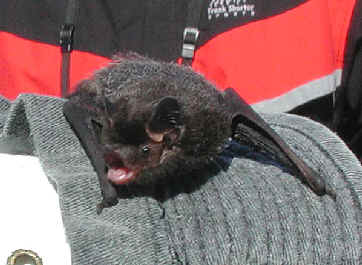
A Silver-haired Bat that
came on our boat
70 miles offshore from New Jersey on Sept. 12, 2004.
(Photograph by Jonathan Klizas)
Marine mammals
during our Sep 12 '04 trip included COMMON (or SADDLEBACK) DOLPHINS, and RISSO'S
DOLPHINS (also known as GRAY GRAMPUS).
Birds seen offshore during our Sep 12 '04 from Barnegat
Light NJ included:
Cory's Shearwaters - 150
Greater Shearwater - 2
Audubon's Shearwaters - 2
Wilson's Storm-Petrels - 300
Red-necked Phalaropes - 25
Red Phalaropes - 2
Pomarine Jaegers - 3
Long-tailed Jaegers - 3
South Polar Skua - 1
Lesser Black-backed Gulls - 2
Merlin -1
American Redstart - 1
Mammals:
Common Dolphin - 6
Risso's Dolphin - 6
Silver-haired Bat - 1
![]()
From FONT Pelagic Bulletin
- May 25, 2004
A
narrative summary of our May 22/23, 2004 pelagic trip from Barnegat Light, New
Jersey, USA
During our annual late-May offshore pelagic birding trip, May 22/23, 2004, from Barnegat Light, New Jersey to the Hudson Canyon, seabirds were not as numerous as they have been during this trip in the past. In 2003, when we saw a tremendous number and variety of birds, the offshore water temperature was as low as 49.2 degrees (with not only numerous birds but with species such as Dovekie and Puffin). Normally, the Hudson Canyon water temperature during our late-May trips has been in the mid-fifties. This year, it tottered about 55.5 degrees F.
But still, with nice weather and good conditions, it was for us an enjoyable day at sea, with a fine variety of bird species.
There were 4 species of shearwaters (Great, Sooty, Cory's, and Manx) along with Northern Fulmar, Wilson's and Leach's Storm-Petrels, Pomarine Jaeger, and Arctic Tern (in addition to offshore Common and Royal Terns, and gulls).
The most common shearwater was the Sooty. There were about 30. That visitor from the South Atlantic was seen at the Hudson Canyon as well as closer to shore.
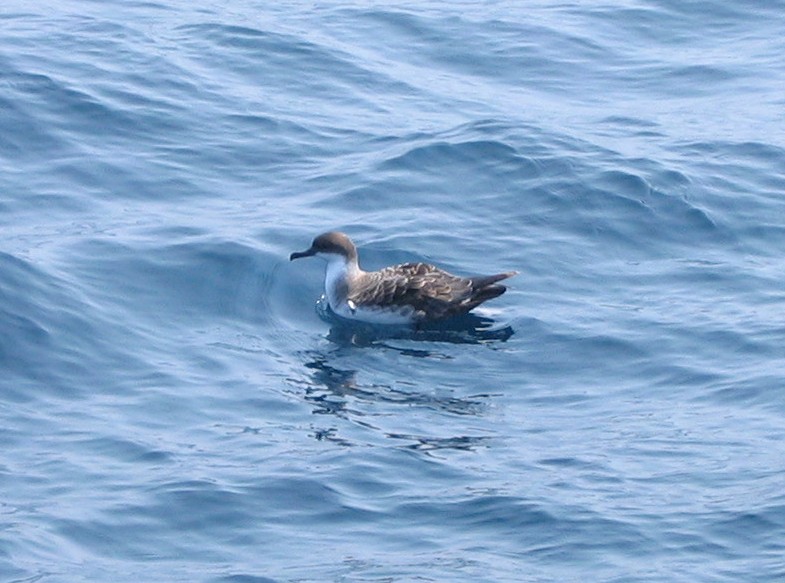
Only 2 Greater Shearwaters were seen, at and near the Hudson Canyon. One sat on the water close to the boat, it being another visitor from the South Atlantic.
May 23rd seems to be an early-date for the Cory's Shearwater that we saw well at the canyon. That species comes from the eastern Atlantic.
Our 2 Manx Shearwaters each flew by the boat quickly, as that species tends to do. But, for most on the boat, the species was seen well. Both of the Manx were in the vicinity of the Hudson Canyon.
The Northern Fulmars were also in the vicinity of the canyon. There were collectively 4 of those tubenoses, that are more common further north in Atlantic. That species was seen well by everyone onboard.
The single Pomarine Jaeger and single Arctic Tern were both seen at the canyon.
Whenever we stopped to chum, Wilson's Storm-Petrels came to our slick, appearing as dancers with dangling feet at the water's surface. During the day, we estimated about 150 of these visitors from the far-southern Atlantic. The 3 Leach's Storm-Petrels were all seen flying at a distance (as that North Atlantic species tends to do). They were not seen by all onboard.
Some birds not normally thought of as oceanic were seen at the Hudson Canyon, when we were about 90 miles from both the New Jersey and New York shorelines. They included a Great Blue Heron, a Magnolia Warbler, an Eastern Kingbird, and a small flock of 4 seafaring Cedar Waxwings.
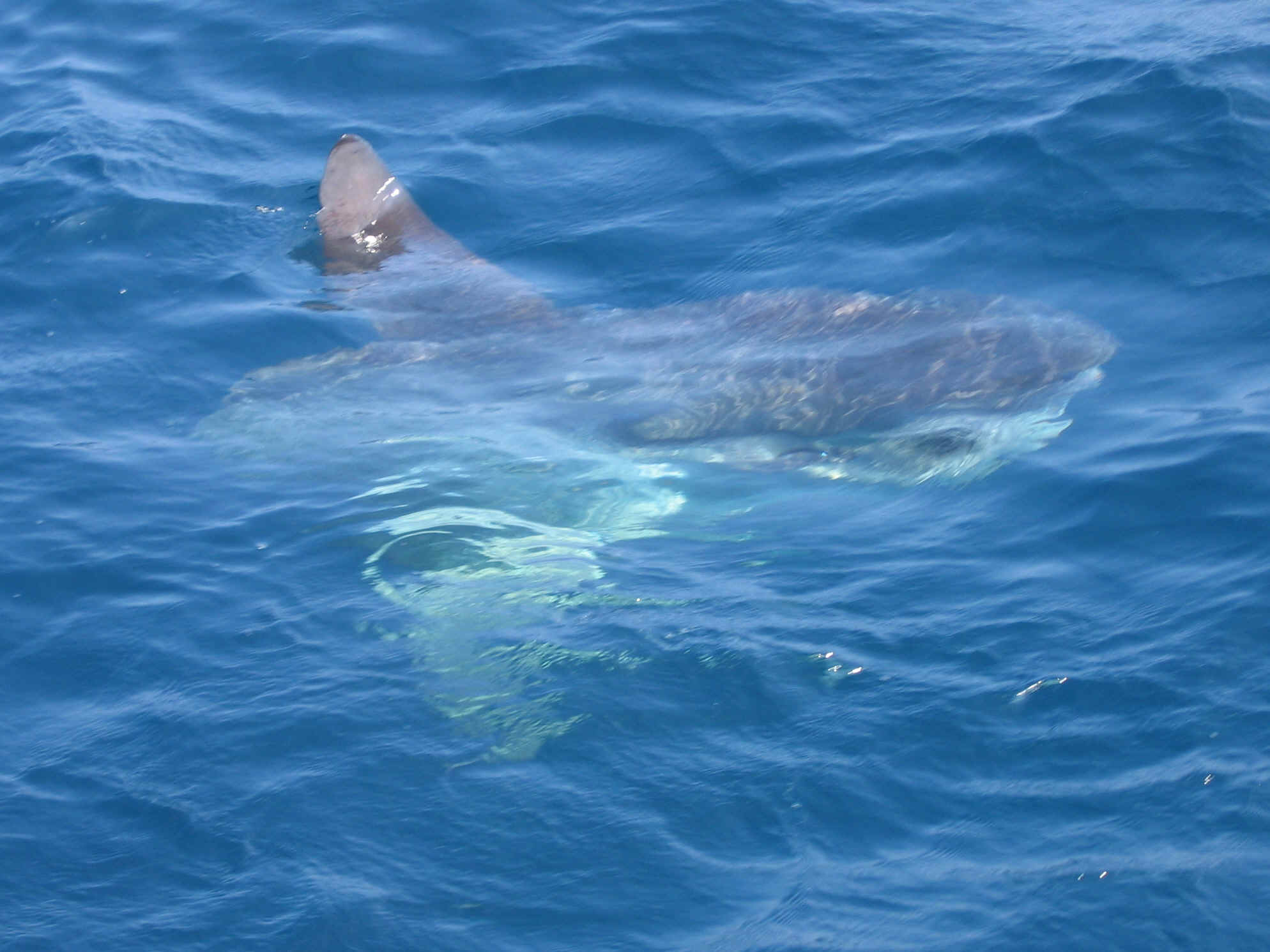
Among the enjoyable aspects of the trip were certainly the marine mammals and some other sea-life. There were in total about 20 Oceanic Sunfish. And 1 Blue Shark. DOLPHINS numbered between 2 and 3 hundred. Some came in close to the boat, while numerous others slightly further from us, were in groups leaping out of the water. They were all the colorfully-patterned Common Dolphin, in the book "Mammals of North America" by Kays & Wilson, called the "Short-beaked Common Dolphin", Delphinus delphis. In the Pacific, where this species also occurs, there is as well a "Long-beaked Common Dolphin". Whatever their beak size, the large group of hundreds of dolphins surrounding our boat in the Hudson Canyon was spectacular.
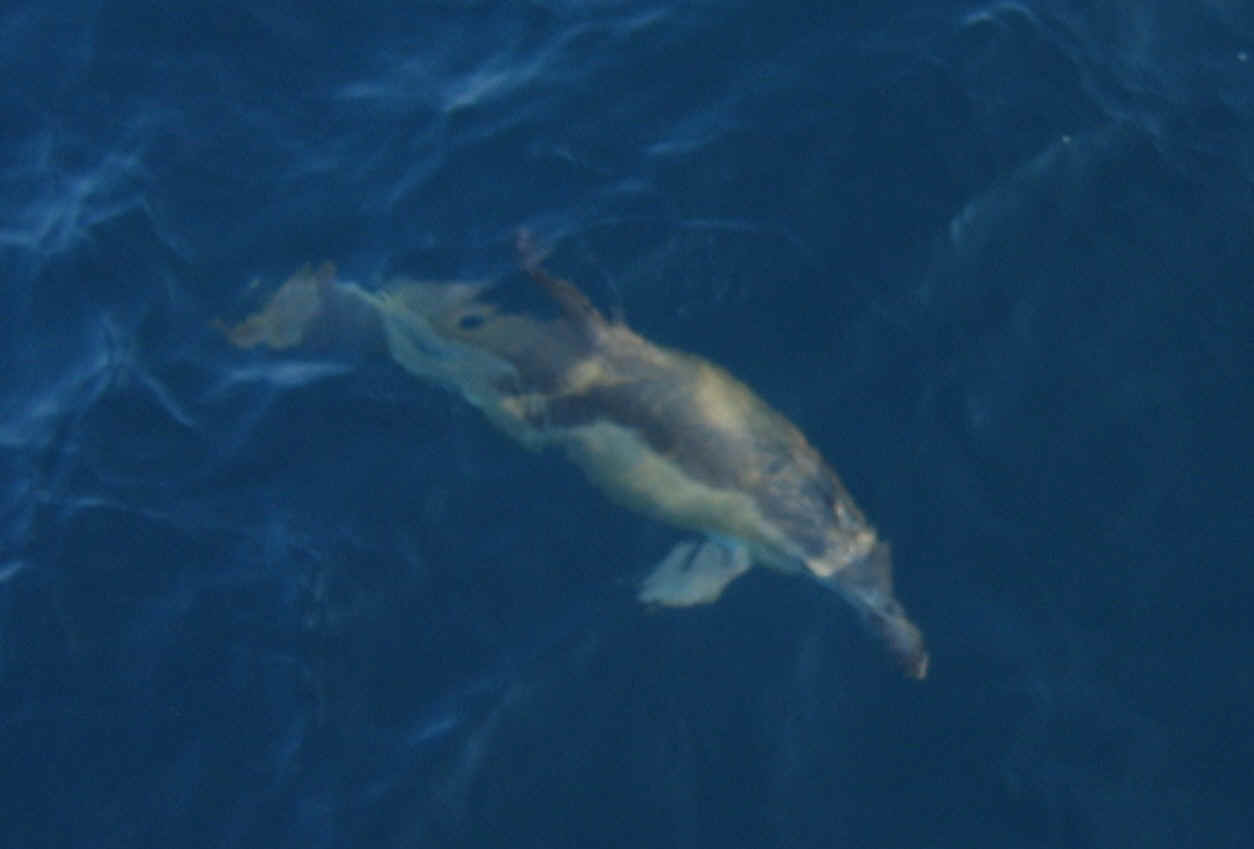
Also quite a sight at the canyon, was a Fin Whale. Blowing, arching, and surfacing, we all could see this large creature, which is the largest of creatures normally occurring in either New York or New Jersey offshore waters. Among the world's cetaceans, only the rare Blue Whale is larger.
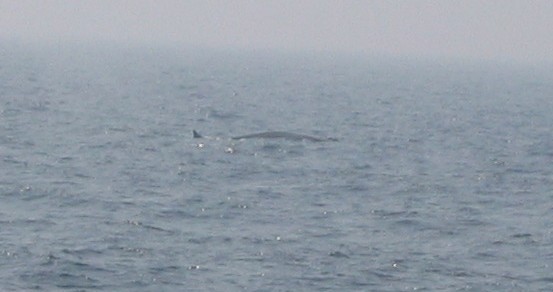
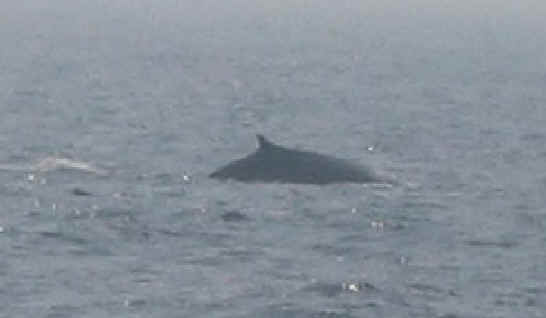
So, again, off New Jersey & New York in late-May, we had a nice trip in oceanic waters onboard the 100-foot boat, the "Doris Mae IV".
We'll be going again, later this year, on the "Doris Mae IV" on our next-scheduled pelagic trip from Barnegat Light, the weekend after Labor Day. It will be another overnight pelagic Saturday/Sunday September 11/12. To be when the offshore waters are warm, and there's opportunities for species such as Audubon's Shearwater and Bridled Tern (if the water's warm enough), and 3 species of southbound jaegers and South Polar Skua, in addition to the bird that's most sought-after that time of year, the White-faced Storm-Petrel.
The cost for the trip is $119. And, again, as there will be sleeping at night, the number of participants will be limited to about 45.
We're hoping (as everyone is) that the already high cost of fuel won't get higher. But, even so, at this time, we're holding at the same price of $119 per person. Please contact us if you'd like to join this trip, which has been so good in the past.
Seabirds at Hudson Canyon in May during Recent Years
Registration Form for Upcoming Pelagic Trip
![]()
FONT Pelagic News - April 1, 2004
Kelp Gulls: subspecies & expansion?
The Kelp Gull, Larus dominicanus, is a circumpolar species in the Southern
Hemisphere. Traditionally, it has been with 2 subspecies:
L. d. domincanus in most of its range, and
L. d. vetula in South Africa and Madagascar.
But now recent work has led to the proposal that the number of Kelp Gull
subspecies be increased to 5:
L. d. dominicanus, the nominate "Kelp Gull" in South America
L. d. vetula, the "Cape Gull", in Africa
L. d. judithae, the "Kerguelen Gull", on subantarctic Indian Ocean
islands
L. d. austrinus, the "Antarctic Gull", on continental Antarctica
and
L. d. melisandae, the "Malagasy Gull", which breeds in Madagascar.
There is an excellent article about the Kelp Gull, with illustrations, in the
British birding magazine, "Birding World", Volume 17, Number 2. (That
publication, by the way, also excellent). For more information, consult the
web-site: www.birdingworld.co.uk
Illustrations in the above-mentioned article include:
the "Kelp Gull", L. d.
dominicanus, with either a pale or dark iris
the "Antarctic Gull", L. d. austrinus, with longer wings than the
nominate
the "Cape Gull", with a dark iris and a pale orbital ring
the "Malagasy Gull", with a longer bill and shorter wings than the
nominate
the "Kerguelen Gull", a smaller bird with a short bill, and always
with white mirrors on the 2 outermost primaries.
Also illustrated:
the "New Zealand Kelp Gull",
L. dominicanus
the "Chilean Kelp Gull", L. dominicanus
the "Falklands Kelp Gull", L. domincanus
the "South Georgia Kelp Gull", L. dominicanus, with ochre-yellow legs
and a very short and stubby bill
Also illustrated:
A Kelp
Gull, presumed to be a "Cape Gull",
L. d.
vetula, in Barbados in the West Indies.
And a rare variant of the Great Black-backed Gull,
L. marinus, with yellow
legs.
Highlighted in the "Birding World" article is a recent "Cape
Gull" in France, a first (for the Kelp Gull) in Europe, at a site, where by
the way, other gull-rarities have occurred: the American Herring Gull, Larus (argentatus)
smithsonianus, the first inland Ring-billed Gull, Larus delawarensis, in France,
and a Caspian Gull, Larus cachinnans.
The article also relates to the "spreading of the nominate Kelp Gull" into North America, noting that some have bred in Louisiana, and that there have been winter records north of there - for example, in Sandgates, Maryland, USA, where an individual has been at the site since first found in January 1998, and still occurring into March 2004. The last known sighting of that bird was on March 21, 2004.
![]()
FONT Pelagic News - April 1, 2004
A Drastic Decline of Albatrosses & Penguins in the Falklands
(the following information from the British publication "Birding
World", Volume 17, Number 2)
During the relatively short time of just 3 years, 44,000 breeding pairs of
Black-browed Albatrosses and 69,000 Rockhopper Penguins have vanished from
Steeple Jason in the Falkland Islands.
The Falklands has been a stronghold of the Black-browed Albatross, with over 70%
of the global breeding population. There have, in recent years, been notable
declines at other Falkland locations as well.
Between 1995 and 2000, over 87,500 breeding pairs were lost in the Falklands, a
rate of 4% per year, or 2 albatrosses per hour.
The reasons ascribed to the population drop have been related in fishing
techniques and recent harmful algal blooms.
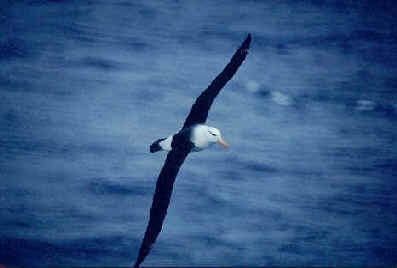
Black-browed Albatross
(Photo by Alan Brady)
Regarding the Rockhopper Penguin, from a population in the Falklands of 89,000
breeding pairs in 2000 at Steeple Jason, only 30,000 breeding pairs at the site.
The species had been thought to be stable during the late 1990s, following a
dramatic population crash in the mid-1980s (from which the species never fully
recovered).
Rockhopper Penguins were seen during a FONT tour in the 1990s, on a small rocky
island, off the southern coast of Argentina. We don't know, now, the status of
the bird there.
To
Top of Page
![]()
From FONT Pelagic Bulletin - December 5, 2003
Dec 7, 03 Pelagic Birding Trip from Barnegat Light NJ
canceled due to weather
Please be advised that due to weather conditions, the pelagic trip from Barnegat
Light, New Jersey, scheduled for Sunday, December 7, is cancelled.
2 storms with more snow than originally expected, are going through the region Dec 5 & 6. Strong winds are projected at sea on Sunday, December 7.
It's difficult to re-schedule for the
next few weeks, with Christmas coming, and with many people participating on
bird counts over the weekends.
But if it's possible to re-schedule for another winter bird pelagic (after
Christmas), we'll advise.
At this time, pelagic trips (for seabirds & marine mammals) are scheduled in 2004, from Barnegat Light, NJ, on the 100-foot, fast boat, the "Doris Mae IV", as follows
Overnight trips:
Sat/Sun May 22/23 (that's the weekend before Memorial Day)
Sat/Sun Sep 11/12 (that's the weekend after Labor Day)
A full-day
trip:
Sat, Dec 4
![]()
From FONT Pelagic Bulletin - September 10, 2003
A summary of the FONT Sep 7/8 '03 overnight pelagic trip from Barnegat Light,
New Jersey
After the trip we received a most-enjoyable e-mail from one of the trip participants, Jared Sparks, of suburban Philadelphia, relating to our day on the ocean. Much of his narrative will be incorporated into the following account.
First, however, the highlight of the trip for many was when an Audubon's Shearwater flushed up in front of the boat, flew to the left side, in front of us, and lit on the water. By it, in the water, was what seemed at first to be large seal or even a small whale. But it was, instead, a massive LEATHERBACK SEA TURTLE. It's big head was above the water's surface, as it was getting some air.
Leatherbacks can dive deeply, down to 4500 feet beneath the surface. Their favorite food are jellyfish. Their breeding grounds are beaches in places such as Florida, Caribbean islands, and the northern coast of South America. They wander widely. Its said as far north as the Arctic. Certainly as far as offshore waters off Ireland. They don't breed on the other side of the Atlantic.
The Leatherback is the world's largest turtle. It can attain a length of over 6 feet, and a weight of as much as 1,200 pounds. The known record for the largest Leatherback is 2,016 pounds. The Leatherback Turtle that we saw by our boat was HUGE.
The night of our departure was still and calm. There was hardly even a breeze.
Hurricane Fabian had moved north, well offshore, just over a day previously. But
that evening the waves were gone. The surface of the ocean was about as smooth
as it could be.
Overhead, in the clear sky, there was a beautiful Moon, and near it, a bright Mars. Not quite as bright as it was a couple weeks earlier when MARS was the closest it would be to us in many thousands of years, but still it shone in the sky, as we headed out of the Barnegat Inlet past the lit-lighthouse.
Now, let's take up with a paraphrased version of Jared's narrative. I summarize at the end, and any interim comment will be in parentheses.
It is fine, lying on the deck in the moonlight, being rocked in the cradle of
the deep as Doris Mae loafs to the abyss. Before sleep, a couple of us pick out
in the warm 1000 pm sky a half-dozen constellations - those of the summer sky.
Brighter evening stars, however, that occur during winter nights, began to appear through our trip. After our sleep, the heavens at 0530 were not a summer sky, but rather, with the sword of Orion and with Sirius, the brightest of our night-time stars.
We look east, with our eyes widened for an expected light. But it's still pitch-black there. With anticipation, though, it's time to get up, and go below for coffee.
The boat, the "Doris Mae" is 18 miles east of "the Tip", an underwater amphitheater, above 3,060 feet of water. The four diesels are silent, as the vessel sits on the sea. The lights of our boat are on, as the light of the new day begins to appear in the east.
On the boat, there are two odors. Inside, fresh coffee and outside, a subtle stink of rotting, ground-up fish known to us as bird chum.
The chumming begins, and nearby, several
birders stand under a lamp that makes the near water the stage of a theater. The
players will come. And so they do. They come with drama, as the night gives up
the dark tatters of itself, They move rapidly, streaming in and out, flitting,
verifying and finally feeding, some in the light from the boat, storm-petrels!
(Over 50 WILSON'S STORM-PETRELS, visitors from the southern reaches of the
Antarctic).
A good day of birding and of being at sea begins.
The AUDUBON'S SHEARWATER was seen later in the morning, at 940 EDT. It was at N 39deg 40.94' and W 72deg 28.91'. At 87 land-miles east-southeast of Barnegat Light, above 360 feet of water, adjacent to the Continental Shelf-edge feature that anglers call "The Tip."
The Tip is a south-facing "seating area" in an amphitheater-shape that's been worn into the shelf by the Hudson River, where the bed of the river goes over the continent's edge. Here, the river's travel from Albany to abyssal depths speeds up. In just a mile and a half of boat-travel farther "down the Hudson, the drowned river-bed drops from a 250ft depth to 800ft. 22 miles further "downriver", the bed is at a 5200 ft depth.
The little Audubon's shearwater, that
flew quickly towards us, came so close to the big Leatherback Turtle, that I and
surely others had both creatures in one binocular field of view.
(Jared relates "What a view, Armas, the the two of them!")
The Leatherback, up for air, was a lot of turtle. The head was at least the
volume of a football. It had at least a four foot length of carapace awash, with
more below the surface ....
There can be strong bird-attractors
offshore. For example, schools of fish, or floating whales, and other vessels
such as commercial fishing boats that are either working, sitting, or moving.
From our boat, we can see trawlers and scallop draggers 3.5 miles away.
Approaching the trawler from New Bedford Mass, called "Linda", got us
some birds, particularly a couple LEACH'S STORM-PETRELS, together with Wilson's.
Earlier, our stopping by the scalloper "Endurance" got us our first
close views of CORY'S SHEARWATERS (visitors from the eastern Atlantic).
The two-bird Leach's sighting that I (Jared) got in on was as one chased the other from the shrimper and across our bow. Their flight, through the nearby Wilson's, was less stodgy than that of the Wilson's, with wings swept-back at wrist, and wings more slender, looking longer. Their rumps appeared darker.
(At another time, during our trip, a large cruise ship came by us, a "Celebrity Cruise" apparently heading south from New York City. By it, and then by us, dolphins appeared. There were about 50 OFFSHORE BOTTLE-NOSED DOLPHINS. By the bow of the ship, they were seen breaching completely out of the water. By the bow of our boat, we could look down on them swimming along with us beneath the surface.)
I (again referring to Jared) have been amazed at times when birds I'll call non-swimmers show up out there. far-out at sea. But consider this
The day's GREAT BLUE HERON appeared 75.4
miles east-southeast of Barnegat Light, flying high in the sky, a bit east of
northward. As it was, the heron might well have made landfall in another 67
miles, at the ocean beach of Moriches Bay, Long Island, after only 2 more hours
of flight. The morning's moderate SE wind, a fair tailwind for the heron, would
have helped get the bird enroute to Long Island.
The heron came north to us. Birds heading south at "The Tip" from
anywhere off Long Island would have had to buck that wind. But at flying speeds
of 30 mph or better, it would have been no more than a 3 hours' flight-time to
us.
Birds, if headed south from "The Tip", when we were there, continuing
to dry land at Cape May, let's say, would have to go 160 miles to make landfall,
if they were to, by the end of the day, as the wind in mid-afternoon backed to
the NE, and strengthened, becoming a tailwind.
Lately, when looking at a map and figuring such speeds and distances, I get a
bit less amazed when birds that are "non-swimmers" appear at a boat of
birders way offshore ....
(In addition to the Great Blue Heron, other offshore landbirds during our trip included a TREE SWALLOW and COMMON YELLOWTHROAT, both more than 80 miles offshore. Also a bird that appeared to be a CLAPPER RAIL was seen in flight about 30 miles out to sea.)
During our pelagic venture, our furthest
point from the parking lot was 105 miles east (that was at daybreak, where we
awakened a few miles eastward of a tuna fleet).
Our miles traveled from the dock back to the dock were 244.
Our time underway was 19 hours and 6 minutes.
The maximum speed of our boat, the "Doris Mae IV", was 28.4 mph
(during speed surges as the 100-foot, 100,000-pound vessel surfs down a swell -
then, of course, it slows some as she climbs the back of the next one.
Thank you, Jared, for taking the time to write about the trip that you so enjoyed.
Thanks are also in order for our spotters during to the trip Nikolas Haass, Rick Wiltraut, Fred Lesser, and Alan Brady.
And to all those involved with the "Doris Mae", thanks for another fine trip (and another great complimentary breakfast spread "that's part of the package").
The biggest thanks from us at FONT, however, are to the participants for joining us, some for the first time, many for yet another time. We appreciate it.
The tally of sightings during the Sep 7/8 '03 overnight pelagic trip from Barnegat Light NJ:
Wilson's Storm-Petrels, 140
Leach's Storm-Petrels, 2
Cory's Shearwaters, 40
Audubon's Shearwater, 1
Red-necked Phalaropes, 3
Lesser Black-backed Gull, 1 (closer to shore)
Herring Gull
Great Black-backed Gull
Common Tern
Black Tern
Offshore Bottle-nosed Dolphin, 50
Leatherback Sea Turtle, 1 (huge, close to boat)
offshore landbirds:
Great Blue Heron
Clapper Rail
Tree Swallow
Common Yellowthroat
![]()
*What was seen
during our May 31, 2003 pelagic trip
from Lewes, DE
(written by Andy Ednie, trip leader)
It was a very good trip, on Saturday, May 31st, out of Lewes, Delaware. That

Pomarine Jaeger,
during FONT's pelagic trip from Lewes, DE,
May 31, 2003.
(Photo by Robert Rufe)

South Polar Skua,
during FONT's pelagic trip from Lewes, DE,
May 31, 2003.
(Photo by Robert Rufe)
![]()
From FONT Pelagic Bulletin - May 27, 2003
*What was seen during our May 25/26, 2003 Hudson Canyon pelagic trip from Barnegat Light, New Jersey
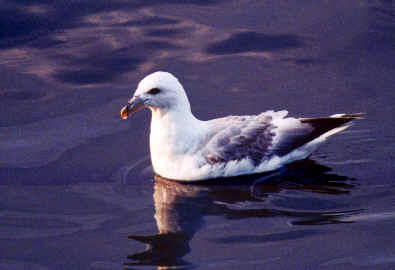
Northern Fulmar,
During our Memorial Day Pelagic Trip from Barnegat Light NJ for 2003, there was some very good seabirding!
We left the dock at 9pm, and arrived at the Hudson Canyon, about 95 miles offshore, about 4am, an hour and a half before dark.
Fortunately for us, the weather
did not affect us as it could have. Onshore, in New Jersey and the Delaware
Valley in Philadelphia, there was from 1.5 to 3 inches of rain through the night
and on Monday morning. Offshore, we had very little rain, and the affect of the
weather was minimal.
Except for one thing the ocean water temperature was as low as 49.2 degrees.
(Normally during our Memorial Day NJ pelagic trips the water temperatures are in
the mid-fifties).
Our wind was from the southeast, and not strong. Nor were there big swells.
We had a good day at sea, and
the affect of that low water temperature was this:
3 DOVEKIES, a PUFFIN, another ALCID (possibly RAZORBILL), about 150 FULMARS, and
6 SOUTH POLAR SKUAS. Not just the SKUAS but all 3 species of JAEGERS, and
numerous SHEARWATERS and STORM-PETRELS, flocks of ARCTIC TERNS and PHALAROPES
(both RED and RED-NECKED) and a lot of GANNETS.
Under the overcast sky and over the ocean water, these were the birds we saw.
In the water, there were GRAY GRAMPUS, and HUMPBACK and FINBACK WHALES.
During our entire time in
offshore waters, there were PELAGIC BIRDS in view. Yes, we were in the North
Atlantic, off New Jersey!!
(In waters designated by various people as both those of New Jersey and New
York.)
When the boat stopped at 4am on the east side of the Hudson Canyon and as we begn to chum, immediately there were birds!!
FULMARS and GREATER SHEARWATERS
began to surround the boat. So, we turned on the bright fishing lights, and then
we watched those birds for about an hour before daybreak, as they gobbled up our
chum. The birds were in so very close!
At it became light, we were surrounded by birds. At one point, 88 FULMARS were
counted on the water (about half of the total we would see).
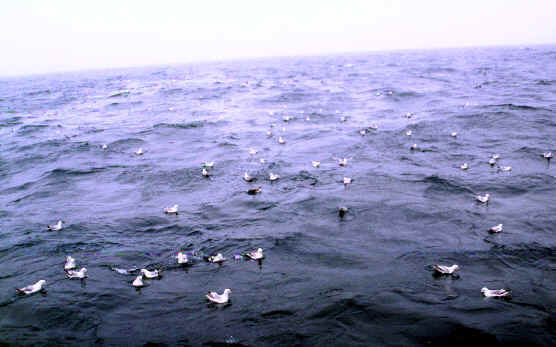
Some of the 150 Fulmars
seen during the FONT May 26, 2003 pelagic trip
from Barnegat Light, NJ.
And, in the middle, 1 of the about 250 Greater Shearwaters
that were to be seen during the day.
These birds on the water close to the boat just after daybreak.
(Photo by Alan Brady.)
Numbers of WILSON'S
STORM-PETRELS steadily increased. A flock of ARCTIC TERNS flew about above the
fulmars and shearwaters. The FULMARS gave their calls. The ARCTIC TERNS scolded.
Our first POMARINE JAEGER of the day came in, and it was as close as the fulmars
and shearwaters (both GREATER and SOOTY).
We could nearly touch that jaeger, a beautiful adult.
Further out, a PUFFIN was seen. It flew to the right, and then left. And then again to the right, and then again to the left, until it lit on the water and disappeared.
Our early morning had been a spectacle. But we had to move, along our chum slick, and across the canyon. As we did, we saw our first DOVEKIE (yes, DOVEKIE). It was on the water, close to the boat. Everyone on the boat could see it well as it stayed on the surface. It was an adult in breeding plumage, that is with an all-black head. It was the first (and best seen) of 3 DOVEKIES we saw in that area. The others not in complete breeding plumage.
Our first DOVEKIE of the day was our first ever off New Jersey in May. And for many of us onboard, that first bird we saw so well was also our first DOVEKIE ever seen in breeding plumage!
Imagine during ONE trip, DOVEKIE and WILSON'S STORM-PETREL (birds respectively of the High Arctic and the Antarctic). Or a trip off New Jersey, with both SOOTY SHEARWATER and DOVEKIE. Has that ever happened previously?
Shortly after the DOVEKIES,
someone said "What's this bird flying at us with red on its wings?) It came
in close to the stern of the boat. It was a YELLOW-BILLED CUCKOO, 90 miles
offshore. It continued flying north toward Long Island (we hope).
Anyway, has there ever been sightings, within moments, of DOVEKIE and
YELLOW-BILLED CUCKOO?
WILSON'S STORM-PETRELS were not
our only storm-petrels. Five times, LEACH'S STORM-PETRELS were seen flying by.
(A "lifer" for some. For many people on the trip, there were
"lifers" during the day.)
When a HUMPBACK WHALE breached in the water right in front of the boat, we stopped (of course!). Above the whale, there were shearwaters. Beneath the water's surface, there were many mackerel. Lots of fish, lots of birds, and the whale. And, there we saw our first 2 SOUTH POLAR SKUAS. One, then both, on the water, close to the boat. Then both flight, close to us.
Later, a FIN WHALE (the 2nd
largest creature on earth) breached largely out of the water in front of us. It
surfaced a few times.
But on the surface of the water nearby, there was something else nice to see, a
flock of PHALAROPES (actually a mixed flock of mostly RED but also RED-NECKED).
Once again, birds were in close to us. We had wonderful looks of both phalarope
species, both males and females, both in full breeding plumage.
Throughout the day, POMARINE JAEGERS kept appearing, often coming in close to us. When we were chumming, again, at the stern, as the whale was somewhere underwater in front of the boat, and the flock of phalaropes still close in on the side of the boat, there appeared behind us, with a POMARINE JAEGER, or two, a duo of LONG-TAILED JAEGERS. In close they came, an adult (with its long tail), and a sub-adult.
And throughout the day, SOUTH POLAR SKUAS kept appearing. Our final tally was 6, all seen close to us in flight or on the water.
As we headed westward toward
shore, the numbers of GANNETS increased, as did those of COMMON TERNS. SOOTY
SHEARWATERS continued.
GULLS were few for us offshore. Only a half-dozen or so each of HERRING and
GREAT BLACK-BACKED, over 60 miles out, where we had another exciting moment.
Near a fishing boat, a large bird in the distance, white and black, caught the
eye of some of us. It did not seem to fly like a gull, nor like a gannet. But it
kept flying away. Whatever, it got away.
But, really, how could we not be happy with what we did see, and saw well.
BIRDS & MARINE MAMMALS during our May 25/26, 2003
pelagic trip from Barnegat Light, New Jersey:
Northern Fulmar, 150
Greater Shearwater, 240
Sooty Shearwater, 180
Wilson's Storm-Petrel, 900
Leach's Storm-Petrel, 5
Northern Gannet, 75
Pomarine Jaeger, 14
Parasitic Jaeger, 1
Long-tailed Jaeger, 2
South Polar Skua, 6
Arctic Tern, 15
Common Tern, 30
Herring Gull, 5
Great Black-backed Gull, 6
Red Phalarope, 20
Red-necked Phalarope, 5
Dovekie, 3
Atlantic Puffin, 1
alcid sp., 1
Yellow-billed Cuckoo, 1 (90
miles offshore)
Barn Swallow, 1 (60 miles offshore)
Gray Grampus/Risso's Dolphin, 1
Humpback Whale, 1
Finback Whale, 1
To
Top of Page
![]()
From FONT Pelagic Bulletin - December 20, 2002
*Birds
seen during Dec 7, 2002 Hudson Canyon pelagic trip from
Barnegat Light, New Jersey
During the FONT (Focus On Nature
Tours) annual early Dec birding pelagic trip from New Jersey, on December 7,
2003:
10 Dovekies, 2 Atlantic Puffins, and 10 Razorbills were among the
oceanic birds seen. Dovekie and Puffin were cooperative, sitting on the water
near the boat. They were seen well.
Such a trip to the Hudson Canyon has been conducted each year since 1992.
Dovekies were seen on consecutive years 1993-98. Since then, the species was not seen again until this year. And, now, as noted, in 2002, a nice number of 10 birds were seen.
Also seen during this year's trip were Red Phalaropes (possibly as many as 200), Greater Shearwater, Manx Shearwater (only 1 seen quickly by some as a "fly-by"), Glaucous, Iceland, and Lesser Black-backed Gulls, in addition to the more-common Gannets and Kittiwakes.
Marine mammals were some Common Dolphins riding for a while by the bow.
The trip this year was from
Barnegat Light, New Jersey, onboard the large, fast boat, the "Doris Mae
IV".
Our thanks to all who played a part with the trip.
One of the primary leaders, just hours before the trip, was diagnosed with
pneumonia, and was unable to be there, so there's a special thanks to others who
pitched in, and to the captain, for enabling people to have the best views
possible of the birds.
![]()
From FONT Pelagic
Bulletin - June 19, 2002
*Summary of sightings from May 2002 Hudson Canyon pelagic
trips from New Jersey
*June 2002 Pelagic Trip from Delaware
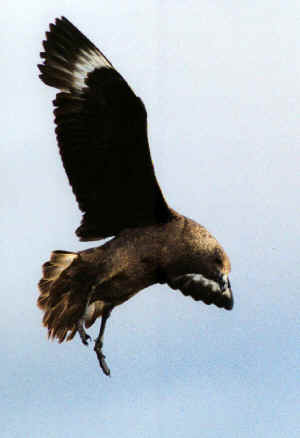
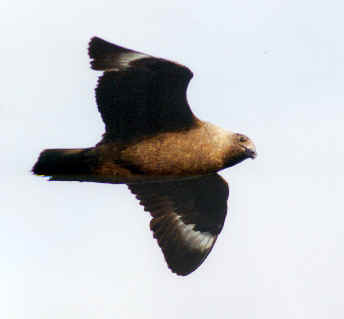
Two photographs of a South
Polar Skua,
during FONT pelagic trip
at the Hudson Canyon in May 2002
(Photos by Rick Wiltraut.)
Summary of sightings from May 2002 Hudson Canyon pelagic trips from Point
Pleasant, New Jersey, on the boat the "Sea Devil":
On May 26/27, 2002
at the Hudson Canyon, from Point Pleasant, NJ:
Common Loon, 4
Northern Fulmar, 13
Manx Shearwater, 22 (that's a good high number. Some seen very well, in
flight and resting on the water).
Greater Shearwater, 6
Sooty Shearwater, 145
Cory's Shearwater, 6
Wilson's Storm-Petrel, 220
Leach's Storm-Petrel, 1
Northern Gannet, 6
Pomarine Jaeger, 1
Parasitic Jaeger, 1
Long-tailed Jaeger, 1 (seen well, close to the boat)
jaeger sp., 3
Great Black-backed Gull, 4 (about 50 miles offshore)
Common Tern, 4
"commic tern", 6
Black Tern, 1
Also, offshore:
Purple Martin, Barn Swallow, Killdeer,
warbler sp.
Sunfish (3), Blue Shark (2), Loggerhead
Sea Turtle (1)
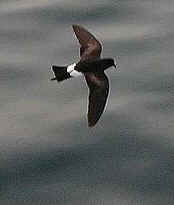
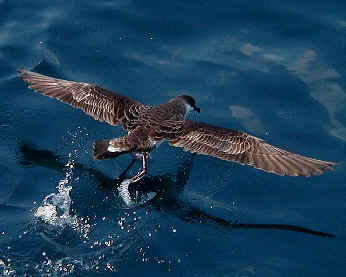
On May 18/19, 2002 at the Hudson Canyon, from Point Pleasant, NJ:
Common Loon, 24
Northern Fulmar, 50
Greater Shearwater, 1
Manx Shearwater, 1
Sooty Shearwater, 30
Wilson's Storm-Petrel, 300
Northern Gannet, 8
Pomarine Jaeger, 6
South Polar Skua, 4 (seen well, close to the boat)
Black Tern, 3
Also, offshore: Greater Scaup, Ruddy Turnstone, Common Dolphin
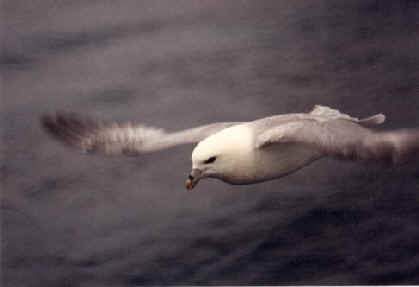
2002 Pelagic Trip from Delaware
Our pelagic trip from Lewes, Delaware, on June 1, 2002 was onboard the "Skipjack":
During the trip, the
following were seen offshore:
Common Loon, 1
Cory's Shearwater, 3
Greater Shearwater, 3
Sooty Shearwater, 83
Manx Shearwater, 1
Wilson's Storm-Petrel, 112
Pomarine Jaeger, 2
Great Black-backed Gull, 2
Herring Gull, 1
Common Tern, 6
Royal Tern, 6
Double-crested Cormorant
Chimney Swift
Yellow Warbler
Brown-headed Cowbird
Finback Whale, 2
Loggerhead Sea Turtle, 2
The June 1 trip was to both Delaware
& Maryland waters. Our thanks to our leader, Bob Rufe, for compiling the
above stats from the trip.
To
Top of Page
![]()
From FONT Pelagic
Bulletin - May 30, 2002
*Sightings during Japan pelagic trip May 18, 2002 on East China
Sea between
Okinawa & Amami
Sightings
during Japan pelagic trip May 18, 2002 on East China Sea between Okinawa &
Amami
FONT actually conducted 2 pelagic trips
on May 18, 2002, at opposite ends of the world:
on the Atlantic Ocean off New Jersey (to the Hudson Canyon from Point Pleasant
NJ, USA),
and on the Pacific Ocean off Japan (in conjunction
with our Southern Japan birding tour). The
Japanese pelagic trip was onboard a ferry, going north between the islands of
Okinawa and Amami.
Birds seen were numerous shearwaters (Streaked, Short-tailed, and Flesh-footed), Swinhoe's Storm-Petrel, Brown Booby, and a flock of Whiskered Terns migrating offshore.
Cetaceans were Pacific White-sided Dolphins, and there were many flying fish.
Tour
information & complete bird-lists relating to FONT Japanese tours.
To
Top of Page
![]()
From FONT Pelagic
Bulletin - March 10, 2002
Caribbean Seabirds & Cetaceans off Dominica
Caribbean Seabirds & Cetaceans, including Great Skua, Tropicbirds, and
Fraser's Dolphin
During the FONT Lesser Antilles March 2002 birding tour, there was, once again, on March 9, a pelagic trip off the coast of the West Indian island of Dominica, where the water gets deep (over 1000 feet) very closely offshore.
Previously, during this pelagic
trip, we've seen very interesting cetaceans, including Sperm and Dwarf Sperm
Whales, and Fraser's and Spotted Dolphins. This time, we again saw
Fraser's
Dolphins (about 50 together) and Pantropical Spotted Dolphins (about a hundred
at once). Sperm Whales were in the area, but we did not see them, or hear them
(with the hydrophone).
But we did see a wonderful
assortment of seabirds. During this trip previously, also in March, we saw
Pomarine Jaegers. This time we saw about 25 Pomarines, as well as one
Great Skua.
Various times at the surface of
the sea, there were schools of fish. They appeared to be small tuna. Jaegers
were feeding on them. Boobies were diving into the water. Frigatebirds were
overhead in a swarm. Some were coming to the water grabbing fish. Others were
harassing jaegers.
During the trip we saw groups of
both Brown and Red-footed Boobies.
At another time, as we were cruising off the beautiful coastline, with the forested hills of Dominica as a backdrop with puffy clouds and rainbows, a White-tailed Tropicbird flew in above us, with its long tail against a blue sky.
A few days earlier, during the tour, when we were atop a high sea-cliff on the island of Saint Lucia, there were about 50 Red-billed Tropicbirds gracefully flying about, calling as they flew.
Our fine day at sea on March 9, 2002 ended with the sun setting over the Caribbean Sea, where we had seen the boobies, jaegers, skua, frigatebirds, tropicbirds, and 2 Lesser Black-backed Gulls (2 of only 4 gulls seen, the others Laughing). As the red solar ball dipped below the horizon, we could see the quick "green flash".
We'll be doing the
Lesser Antilles Birding Tour again during the late Winter of 2003. Seabirds are just part of the tour. There are also
some wonderful landbirds, ranging from parrots and colorful hummingbirds to
endemics, rarities, and other specialties such as two tremblers and the
White-breasted Thrasher.
To
Top of Page
![]()
From FONT Pelagic
Bulletin - Dec. 5, 2001
Pelagic Birding Trip from Brielle, New Jersey, Dec 1, 2001.
Pelagic Birding Trip from Brielle, New Jersey, Dec 1, 2001.
On Saturday, December 1st, FONT conducted its 9th annual all-day birding pelagic trip in December onboard the "Atlantis" from Brielle, New Jersey. It was certainly the warmest weather that we've ever had for a December pelagic. Onshore, the temperature reached a record 72 degrees F. Offshore, the air temperature was a bit cooler, but the heavy clothing was not necessary this year! The water temperature ranged from 55 to 57 degrees F.
We may have had the most CHUM ever! Chumming all-day, during the entire trip, meant that birds were with us all the time. And it may have been our most potent chum ever! Fulmars and other seabirds, we're sure, could smell what we were offering them from many, many miles away.
Gulls and Gannets were with the boat throughout the trip. The first Fulmar appeared 24 miles offshore, and we had that species with us all day until nearly dark. Our tally of Fulmars for the day was 52.
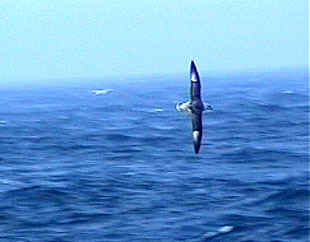
Northern Fulmar,
photographed during
FONT's Dec 1, 2001 pelagic trip,
from Brielle, New Jersey.
(Courtesy of participants, Judy & Karl Lukens)
A large number of Kittiwakes were with us throughout. Their tally was over 1,200. Most of the day, adults were with us. Late in the day, juveniles became more evident.
A large number of Red Phalaropes were seen. Flocks tallied up to between 4 and 5 hundred.
During this trip, we hope for Great Skua (We've seen it in the past.) We've also seen, on occasion, Pomarine Jaegers. This time our count of Jaegers was 19 Pomarines and 1 Parasitic.
2 Manx Shearwaters were seen during the trip.
During this trip, we hope for Dovekie (We've
seen it in the past). This time, maybe the surface of the water was not
smooth enough, but 3 species of ALCIDS were seen Razorbill, Atlantic
Puffin, and Thick-billed Murre.
All of these were seen sitting on the water. The Puffin only quickly. But
the Razorbill and Murre were seen longer, and probably by everyone
onboard.
What we did not see were fishing boats offshore. Often, during December trips, we find large groups of birds around such boats. This time, we did succeed in finding large groups of birds on the water - minus the boats.
Under the water, and leaping above it, were two large groups of Common, or Saddleback, Dolphins. Our estimated count of them was 180.
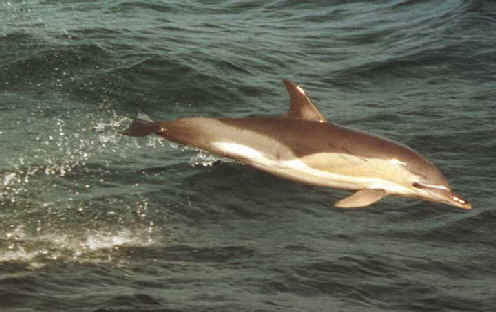
Common Dolphin
photographed during Dec 1st pelagic trip, from Brielle, New Jersey by
participant, Andy Smith, from Devon, PA.
It was a good day at sea! Every day there
is different. We look forward to going again. Our 2002 schedule of FONT East
Coast pelagic trips will be out SOON. Within a few days, in our web-site, at www.focusonnature.com
Lots of other pelagic trip and tour information is in that web-site now. There
are accounts of what we've seen since 1992.
Our thanks to all who joined us in 2001. We're glad to have had you with us. We hope you enjoyed your trips.
My thanks to all who enabled the trips to happen, from those in the FONT office, to our top-notch leaders and spotters, and the captains and crews on the boats. We endeavor to have leaders who enthusiastically share, adept captains who maneuver for the best views, and also, as we did, this past week out of Brielle, crews who don't mind dispersing potent chum all day long!
The Dec 1, 2001 Brielle, New Jersey tally of birds & marine mammals:
Common Loon, 4
Red-throated Loon, 2
Northern Fulmar, 52 (including 9 gray-morphs)
Manx Shearwater, 2
Northern Gannet, 134
Red/Grey Phalarope, 451
Pomarine Jaeger, 19
Parasitic Jaeger, 1
jaeger sp., 5
Laughing Gull, 3
Bonaparte's Gull, 128
Herring Gull, xxx
Lesser Black-backed Gull, 4
Great Black-backed Gull, xxx
Black-legged Kittiwake, 1259
Thick-billed Murre, 1
Razorbill, 3
Atlantic Puffin, 1
Common Dolphin, 180
Nearly all of these in both New Jersey & New York waters. Only a few single-staters.
Coordinates for the rarer birds:
Manx Shearwater 39º 52.584 - 73º 06.040
Thick-billed Murre 39º 58.270 - 73º 22.582
Atlantic Puffin 39º 57.546 - 73º 18.888
![]()
From FONT Pelagic Bulletin
- Nov. 17, 2001
Pelagic Birding Trip
off Chile, South America, Nov 2001
Pelagic Birding Trip off Chile, South America, Nov 2001
On
November 1, 2001, Focus On Nature Tours conducted its annual pelagic trip on the Pacific off the Chilean coast of South America, from Valparaiso. The first such trip for FONT was back in November 1990. This half-day pelagic trip is part of the FONT Chile Birding Tour, and in 2001 it was, again, a great success.On our boat, it was indicated that the capacity was 80 passengers. There was excellent viewing from the sides and front of the boat. We certainly did not have 80 people onboard, but those with us were treated to hordes of birds around the boat, during virtually the entire trip. Again, we had plenty of chum to attract the birds close to us.
There were pelicans, petrels, penguins, and phalaropes. And more, much more.
4 species of Albatrosses
were seen during the trip Black-browed, Gray-headed, Salvin's, and
Buller's.
Shearwaters were numerous, both Pink-footed
and Sooty.
Giant-Petrels and Diving-Petrels
were seen well, Southern and Peruvian respectively. Storm-Petrels
were Wilson's.
At our furthest point out, there were hundreds of birds close to our boat.
Lots of pelicans and shearwaters. Nice numbers of albatrosses.
From 40 to 50
Terns, during the trip, included South American and Arctic, the latter from North America. Gulls included Kelp and Franklin's. The latter, particularly numerous, migrants from interior North America.
Also migrants from the Northern Hemisphere were the flocks of Red (or Gray) Phalaropes.
Add to the mix, Humboldt Penguins on the water, both White-chinned and Westland Black Petrels, Guanay Cormorants, and Peruvian Boobies. It was a great outing at sea, off the Pacific Coast of South America.
![]()
From FONT Pelagic Bulletin -
Sept. 6, 2001
Summaries
of pelagic
trips from New Jersey:
Sept 3/4, 2001, at the Hudson Canyon, from Barnegat Light, with White-faced Storm-Petrel & much more.
Sept 2, 2001 from Cape May.
May 25/26, 2001 at the Hudson Canyon, from Barnegat Light.
Pelagic
trip from New Jersey, Sept 3/4, 2001 with White-faced Storm-Petrel & much more
The evening of September 3, we departed from Barnegat Light, New Jersey on an overnight pelagic trip onboard the boat the "Doris Mae".
We slept well. The seas were calm and would be during our entire outing the next day. We arrived at our intended destination, the Hudson Canyon, about 85 miles offshore, when it was still dark.
A chum-slick was put onto the water. It became large, attracting early in the morning a large number of birds. There were many Wilson's Storm-Petrels (maybe a thousand - 1500 during the entire trip). Also Cory's, Greater, and Audubon's Shearwaters (15 of the latter for the day.)
Some jaegers flew in. All the species were seen closely.
And, then, there was the "soft-spoken" call "there's a WHITE-FACED STORM-PETREL". It was not as close at first as we would have liked, but the light-colored bird, with its dangling feet, could certainly be seen.
As it had appeared, it disappeared. So we traveled along the long slick and lo and behold, we found it again, rather off by itself from the Wilson's Storm-Petrels. Our boat got close to the bird, as it continued to move low over the water, We (actually our adept captain) stayed with it for 20 minutes as it continuously flew, in its odd way. The bird was moving, as we were, at a speed of 12 knots, but its wings were hardly moving at all. Its long legs were hitting the water one bounce after another, bringing to mind to some of us, a bird on a pogo stick and to others an avian kangaroo. We wondered if it had come in that manner all the way from the Azores!
The White-faced Storm-Petrel was so close to our boat as we accompanied it. Photos are below.
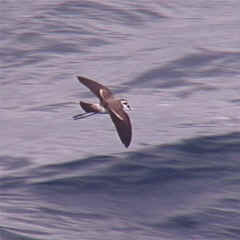
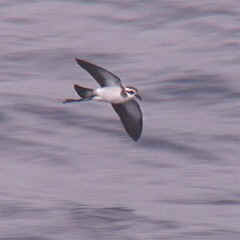
White-faced
Storm-Petrel,
during FONT's Barnegat Light, New Jersey, pelagic birding
trip,
September 4, 2001.
But our day at sea was far from over when we veered away from the White-faced Storm-Petrel.
During the trip, nearly a dozen Pomarine Jaegers were seen - closely - adults, sub-adults, and birds of the year.
And a Long-tailed Jaeger was seen. It, too, close to us, and as we did with the White-faced Storm-Petrel, and as we did with the White-faced Storm-Petrel, we traveled with it as it flew - for quite a while. Our speed with Long-tailed Jaeger next to us was up to 20 knots. Again, an adept captain. As with the White-faced Storm-Petrel, a nice bird was put on video.
In addition to the birds there were some other oceanic creatures that we enjoyed:
A large Manta Ray, early in the morning right by the boat. It stayed with us for a while, as remoras stayed with it.
Also large, a swordfish was seen closely. Its huge fins were above the water. Sometimes that big fish comes to the surface after some doing some fishing of its own in the deep. Swordfish attain a length of 15 feet and a weight of 1300 pounds.
We learned on the radio from a nearby fishing boat that the largest of all the world's fish, a Whale Shark was seen in the area. We unfortunately did not see it.
(There's a photograph of this massive creature in our web-site in the Marine Life Photo Gallery. That picture was taken during one of our offshore Puerto Rico boat-trips.)
Even larger than the Whale Shark
is the Fin Whale (the second largest
creature in the world).
7 were seen during our trip, including one that remained still for a while just
beneath the surface of the water only yards (less than 50) from our boat. Later,
4 Fin Whales were close to the boat, with 2
swimming underneath it.
Other marine
mammals included:
a Humpback
Whale,
a group of 8 Gray Grampus, or Risso's Dolphins (again,
seen closely)and a larger group of about 70 Offshore
Bottle-nosed Dolphins. They were swimming by the boat, rapidly at the
bow. We could look down on them - the adults with their young. (The adults
always putting themselves between their youngsters and boat).
And then it was time for us to go back to shore. In about 4 hours, we were back at the dock. It had been a fine trip.
Most of the sightings were about
80-90 miles offshore from the New Jersey coast, but the closest land to us, when
we were at the Hudson Canyon, was actually Long Island, New York.
The tally of the Sept 3/4, 2001 pelagic trip from Barnegat Light, NJ:
Cory's Shearwater, 32
Greater Sherwater, 23
Audubon's Shearwater, 15
Wilson's Storm-Petrel, 1500
WHITE-FACED STORM-PETREL, 1
Red-necked Phalarope, 1
Pomarine Jaeger (about 10)
Long-tailed Jaeger, 1
Herring Gull (not at the Hudson Canyon)
Great Black-backed Gull (not at the Hudson Canyon)
Common Tern, 6
Arctic Tern, 2
a few terns too distant to ID
Fin Whale, 7
Humpback Whale, 1
Risso's Dolphin (Gray Grampus), 8
Offshore Bottle-nosed Dolphin, 70
Manta Ray, 6
2 Remoras with the Rays
Swordfish, 1
Not as large a fish, but certainly the most colorful of the day were the Dolphin
(fish) or Mahi-mahi. At times, skipjacks
and tuna were seen jumping at the
water's surface.
![]()
Birds seen during pelagic trip off Cape May, NJ,
September 2, 2001:
During the FONT all-day pelagic trip, on Sept
2, out of Cape May, New Jersey, a Bridled Tern was seen, as
were Pomarine Jaeger, Cory's Shearwaters, and Wilson's
Storm-Petrels.
![]()
Birds seen at the Hudson Canyon during pelagic trip off New Jersey May
25/26, 2001:
Common Loon, Northern Fulmar
(39), Cory's Shearwater, Greater Shearwater (32), Sooty Shearwater, Wilson's
Storm-Petrel (950), Leach's Storm-Petrel (5), Northern Gannet,
Red-necked Phalarope, Red
Phalarope (32), Pomarine Jaeger (49), Parasitic Jaeger,
Long-tailed Jaeger, South Polar
Skua, Lesser Black-backed & other Gulls, Black-legged Kittiwake, Common Tern, and
Atlantic Puffin (2).
Other marine-life included: Common Dolphin, Loggerhead Turtle, and Mola-mola.
![]()
From
the 2001 issue (volume 33) of the "Delmarva Ornithologist",
edited by Gene Hess, (a
publication of the DOS, the Delmarva Ornithological Society),
the following are excerpts from an article by Andrew Ednie (who has been
a leader on a number of our Delaware pelagic trips):
(Gene Hess has led Delaware land-birding tours for FONT.)
Pelagics,
the final frontier. No form of birding presents so many obstacles, from
arranging transportation, to the right weather conditions, to the hazards of
motion sickness. Whenever you're out on the open ocean, you never can tell what
to expect. The probability of finding a new state record (for Delaware) when
traveling into oceanic waters has been better (recently) than when birding on
dry land. Our knowledge of pelagic species occurrence is limited. Except for the
unusual one-day trip offshore, which represents just a small snapshot of
what normally occurs, there is little continuity. It is almost impossible to
follow-up a rarity report with further observations.
The year 2000 was exceptional for birding Delaware's pelagic waters. It was even
more special with the publication of the book "Birds of Delaware". In
it, the Delaware-Maryland border was defined as 38 degrees 27'4" N.
There were 6 pelagic trips to Delaware waters in 2000. That's twice as many as
in any other year and an 18% increase in total records for Delaware. Trips
scheduled for the first week in March , the first and second week of June, and
the first week of September were all dates previously undocumented. One new
species was added to the Delaware state-list, plus there were records for such
infrequently recorded species as Northern Fulmar, Manx and Audubon's
Shearwaters, Leach's Storm-Petrel, South Polar Skua, and Atlantic Puffin.
The number of pelagic birds observed was impressive. A highlight was the record
number of Bridled Terns that appeared on the two September 3 trips. A
full list of the oceanic species seen will follow in this
article.
Two deep water canyons are found off Delaware and Maryland. The northernmost is
the Wilmington Canyon, about 90 miles east of South Bethany Beach DE. The
southern canyon is the Baltimore, about 65 miles east of Ocean City MD. At the
canyons, there is a deep drop at the Continental Shelf. This drop causes an up
welling of nutrients from the ocean floor. Nutrients increase food supplies,
producing feeding areas for deep water pelagic species: fish, bird, and marine
mammal.
In 2000, most of the pelagic trips concentrated their time close to the 30
fathom line . There are several colorful terms for the unique geographical
features found along that line. To the south, the closest is the 19 Fathom
Seamount, about 40 miles east of South Bethany, DE. Beyond that, the 30
fathom line goes north, and then back south for 5 miles. That long contour line
is known as the Elephant's Trunk, due to its unusual shape. The
Elephant's Trunk begins about 45-50 miles east of Indian River (DE) and runs
south to 45 miles east of Fenwick Island (DE). South of the Elephant's Trunk,
east of Ocean City, in Maryland waters, there is a bowl-shaped bulge in the 30
fathom line, known as the Tea Cup. This is an area of extensive trawler
fishing and sport fishing for tuna in the summer. While a good number of pelagic
birds can be further out at the deep water canyons (Wilmington & Baltimore),
boat captains say that there can be large concentrations of birds at the closer
features just mentioned.
PELAGIC TRIPS TO
DELAWARE WATERS in 2000:
March 6, on the "Miss Chris" from
Cape May, NJ, southeast to the north tip of the Elephants Trunk
Partly cloudy, mild, wind SW at 5-10 mph. Air temp: 40-55 degrees F.
Highlights: Atlantic Puffin, Northern Fulmars, Kittiwake, and multiple Razorbills
at the north tip of "Elephant's Trunk".
May 30,
FONT trip on the "Morning Star" from Cape May NJ, through the mouth of
the Delaware Bay to just north of the "Elephant's Trunk".
Clear to mostly cloudy. Rough seas. Air temp: 55-75 degrees F.
Large number of Sooty Shearwaters at the mouth of the Delaware Bay.
June 3, FONT trip on the
"Skipjack" from Lewes, Delaware. SE to the "Teacup", north
along the "Elephant's Trunk".
Clear, calm, winds S at 5-10 mph. Seas 2 to 4 ft. Air temp: 60-70 degrees F.
Water temp: 52-56 degrees F.
Highlights: South Polar Skua, Atlantic Puffin, and many shearwaters
with trawlers at the "Teacup". The puffin along the
"Elephant's Trunk".
June 10, FONT trip on the
"Skipjack" from Lewes, DE, southeast to the "Teacup", north
along the "Elephant's Trunk".
Clear to partly cloudy, wind W at 10-15 mph. Seas 4 to 8 ft. Air temp: 60-68
degrees F. Water temp: 54-58 degrees F.
Highlights: multiple jaegers among trawlers at the "Teacup". Manx
Shearwater near the 19 Fathom Seamount.
Sept 3, FONT trip on the "Morning
Star" from Cape May NJ, southeast to the north tip of the "Elephant's
Trunk", east to Wilmington Canyon.
Hazy, fog, calm, wind SE 5-10 mph. Seas 2-4 ft. Air temp: 72-80 degrees F. Water
temp: 75-80 degrees F. Large mats of sargassum.
Largest number of Bridled Terns recorded in mid-Atlantic region. Audubon's
Shearwaters.
Sept 3, FONT trip on the
"Skipjack" from Lewes, Delaware, SE to 19 Fathom Seamount, the
"Teacup", east to the 40 fathom line. Same conditions as above Sept 3
trip.
Highlights: Long-tailed Jaeger, a Delaware state record. South Polar
Skua at 19 Fathom Seamount. Long-tailed and Pomarine Jaegers
at the "Teacup". Two flocks of phalaropes. Multiple Bridled
Terns.
NOTES REGARDING SOME OF THE OCEANIC BIRDS:
Manx Shearwater: A single bird flew past the
boat on June 10. It was seen about 43 miles east of North Ocean City, Maryland,
halfway between the Elephant's Trunk and the 19 Fathom Seamount (the latter site
in Delaware waters). The bird appeared off the starboard, passed off the bow,
and then flew away off portside. This shearwater is considered common off
mid-Atlantic waters. It is not considered a "review bird" for
Maryland, but there were (as of Jun 10, '00) only 6 documented records for
Delaware (Hess, 2000). This bird was very close to Delaware waters, and the
possibility that it passed into Delaware was quite real.
Audubon's Shearwater: Seen on the Sept 3
trip from Cape May.
Leach's Storm-Petrel: First spotted by the
mate, then seen alongside the boat at 0730 on June 3. The longer wings and more
bouncy flight pattern distinguished this species from the more common Wilson's
Storm-Petrel.
Long-tailed Jaeger: The trip on Sept 3
onboard the "Skipjack" produced 2 sightings of this species, one in
Maryland, the other in Delaware. They represented the 8th record in Maryland,
and the first state record for Delaware. Both were juveniles, birds of the year.
The Maryland bird was seen with 5 Pomarine Jaegers for good size comparison. It
was found about 50 miles east of Ocean City, among trawlers fishing the 45
fathom line. The Delaware bird was seen at the 19 Fathom Seamount.
South Polar Skua: One was seen during the
June 3 trip at the "Teacup", about 45 miles east of Ocean City,
Maryland. The bird flew in off the sten to harass shearwaters (Greater and
Sooty). The bird was within 25 feet of the boast, allowing numerous photographs
for documentation.
Another South Polar Skua was seen during the Sept 3 trip onboard the
"Skipjack". The bird flew in to a flock of Cory's Shearwaters at the
19 Fathom Seamount. This bird also approached quite close to the boat, allowing
photographic documentation. This was the 2nd state record for Delaware. Both
birds were dark morph juveniles.
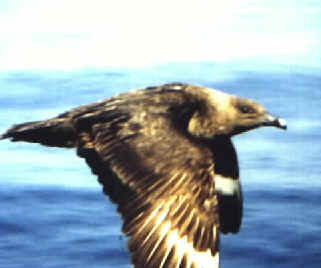
South Polar Skua,
during
FONT
Bridled
Tern: The first for 2000 was on June 3, 19 miles southeast of Cape
Henlopen. Most records for this species (off Delmarva) have been in the late
summer. This was the second June Delaware record.
The trips on Sept 3 were interesting because the water temperature was warm,
reaching 80 degrees F., and thick mats of sargasso weed were found. There were
many sightings of this species on the two Sept 3 trips. On the
"Skipjack", 18 individuals were recorded: 13 in Delaware and 5 in
Maryland. The first was seen at the 19 Fathom Seamount. One group of eight
individuals was seen along the Delaware/Maryland border, just west of the
"Elephant's Trunk". Almost all of the birds were adults.
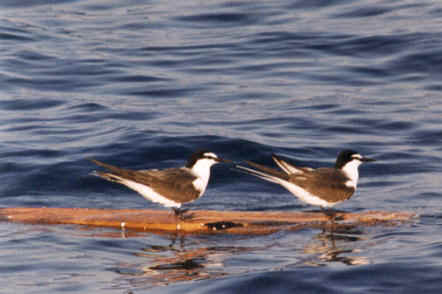
Atlantic
Puffin: A total of 3 birds were observed on June 3 from the
"Skipjack". One bird was in Delaware waters, while 2 were over the
border in Maryland. All of the birds were thought to be sub-adults with pale
faces and small bills (without much color on the
bill).
COMPLETE LIST OF OCEANIC BIRDS SEEN OFFSHORE IN
DELAWARE & MARYLAND DURING 2000:
Common Loon:
Jun 3 (15 DE), Jun 10 (1 MD) Sep 3 from Cape May (2)
Northern Fulmar: Mar 6 (4 DE)
Cory's Shearwater: May 30 (1 DE), Jun
3 (4 DE, 5 MD), Jun 10 (2 DE, 7 MD), Sep 3 from Cape May (11), Sep 3 from Lewes
(14 DE, 9 MD)
Greater Shearwater: Jun 3 (45 DE, 74
MD), Jun 10 (4 DE, 204 MD), Sep 3 from Cape May (15), Sep 3 from Lewes (15 MD)
Sooty Shearwater: May 30 (7 DE), Jun 3
(161 DE, 269 MD), Jun 10 (7 DE, 158 MD)
Manx Shearwater: Jun 10 (1 DE)
Audubon's Shearwater: Sep 3 from Cape
May (2)
Wilson's Storm-Petrel: Jun 3 (150 DE,
250 MD), Jun 10 (44 DE, 33 MD), Sep 3 from Cape May (59), Sep 3 from Lewes (74
DE, 46 MD)
Leach's Storm-Petrel: Jun 3 (1 DE)
Northern Gannet: Jun 3 (9 DE), Jun 10
(5 DE, 1 MD)
Brown Pelican: Jun 3 (4 DE)
Red-necked Phalarope: Sep 3 from Lewes
(7 DE, 4 MD)
South Polar Skua: Jun 3 (1 MD),
Sep 3 from Lewes (1 DE)
Pomarine Jaeger: Jun 3 (2 DE), Jun 10
(5 MD), Sep 3 from Lewes (1 DE, 5 MD)
Parasitic Jaeger: Jun 10 (3 MD)
Long-tailed Jaeger: Sep 3 from Lewes
(1 DE, 1 MD)
Black-legged Kittiwake: Mar 6 (1 DE)
Royal Tern: Jun 10 (8 DE)
Common Tern: Jun 3 (6 MD), Jun 10 (16
DE, 3 MD)
Bridled Tern: Jun 3 (1 DE), Sep 3 from
Cape May (23), Sep 3 from Lewes (13 DE, 5 MD)
Black Tern: Sep 3 from Lewes (4 DE)
Atlantic Puffin: Mar 6 (2 DE), Jun 3
(1 DE, 2 MD)
MARINE MAMMALS:
Bottlenose Dolphin: Jun 3 (18 DE), Sep
3 from Lewes (6 DE)
Common Dolphin: Sep 3 from Lewes (30
MD)
OTHER MARINE LIFE:
Loggerhead Sea Turtle: Jun 3 (2 DE, 1
MD), Sep 3 from Lewes (1 DE, 1 MD)
Leatherback Sea Turtle: Jun 3 (1 DE), Sep 3
from Lewes (1 DE)
Mola mola: Sep 3 from Lewes (1 DE)
Yellowfin Tuna: Sep 3 from Lewes (MD)
BUTTERFLY:
Cloudless Sulphur: Sep 3 from Lewes (1
MD)
Our thanks to the various boat captains & crews,
our pelagic trip leaders, and of course to the trip participants for traveling
with us.
Birds & other Marine-life during previous FONT trips from New Jersey (1992-1999).
Birds & other Marine-life during previous FONT trips from New Jersey (2000-2002).
Also Photo Galleries of Oceanic Birds & Other Marine Life.
To
Top of Page